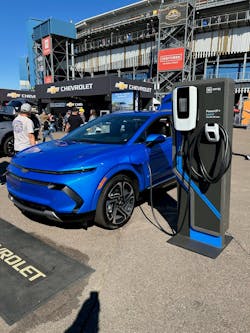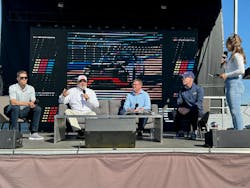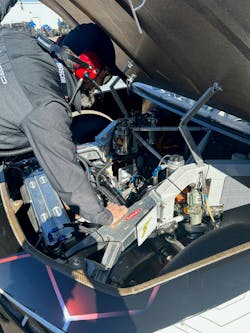The full-load torque of the future moved fast and early Saturday of NASCAR Championship Weekend at the Phoenix Motor Speedway in the edge of the hilly deserts of Arizona.
Before Joey Logano held off teammate Ryan Blaney in the No. 22 car to win both the last leg and NASCAR championship one day later, before the starting gun fired on the main event, the future swerved around the four turns and two straightaways of the mile oval in the form of a No. 35 car that looked like most of the others on the outside and nothing like them on the inside.
NASCAR exemplifies the breakneck speed of American car engineering at its most thrilling and raucous. This time around, though, its relatively new partnership with Swiss-based electrification firm ABB passed a critical first step in the evolution of high-performance U.S. electric vehicle technology.
Test Driver David Ragan pushed the three-electric-motor, 1,300-horsepower EV prototype car some 30 laps around Phoenix Speedway at up to 155 miles per hour, every bit as fast as the cars driven by Logano and Blaney in the thrilling finish one day later Sunday, Nov. 10.
The No. 35 car sped all alone out there Saturday in-between qualifying laps, racing into the fray to both learn more and create new interest within the most internal-combustion-engine-loving audience in all of America.
“Getting all the test sessions in are really the first of firsts,” Ragan said once emerging out of the driver’s seat of the EV prototype engineered with Ford, GM and Toyota with the help of ABB.
“It’s groundbreaking,” the driver said. “I think we’ll look at this day in another 10 to 15 years and think about how we were making a breakthrough.”
If EVs can win hearts at NASCAR, they can win anywhere
And those breakthroughs were achieved in a bastion where faster is better, while the past is always revered. Cars commemorate the driving genius of legends such as Richard Petty reside majestically along the facility’s midway, where NASCAR fandom feels more like a state fair than a Super Bowl. Once again, ICE is king here—internal combustion engine.
So why here? Well, if EVs can win over this crowd, eventually they can win anywhere.
But it’s more than that: NASCAR is at the starting line of an all-encompassing decarbonization journey that will take it many laps around through 2035. In fact, 35 is both a car number and symbolic nod to the stock car icon’s desire to reach a net zero goal in 11 years.
No, the racing series is not going electric, car-wise, any time soon. But NASCAR owns about 15 speedways, many Class 8 transport trucks and will work with ABB, its Impact partner, to explore cleaner energy outcomes such as LED lighting, energy efficiency, electrification of transport and equipment and even microgrids in the future.
“We’re also a logistical business,” Riley Nelson, NASCAR’s head of sustainability, said in an EnergyTech interview at the Phoenix Speedway. “We’re focusing on decarbonization starting with our facilities. We’re in the third year of measuring our carbon footprint.”
The company is moving fast, no surprise, and working with ABB has cut emissions some 15% in some operations in just a year. Building management is first, solar and battery storage should be coming.
From NA+ to Volanic Geothermal: Check out our new E-Book
An energy transition is sometimes a bumpy ride. Even so, NASCAR’s recipe is working and will only get better, Nelson pointed out.
“It’s like making pancakes,” she said. “The first one is lumpy but by the third it’s pretty good.”
Racing to electrification begins at home
NASCAR is not really a racecar company; it doesn’t own those sleek speed machines which are the work of incredible sponsorship and engineering partnerships. But it does own more than a dozen facilities around the country, and it also basically moves like a carnival from track to track for each’s week races. The 2024 season is over, but the 2025 start at the Daytona 500 is only a few months away.
So, what does the NASCAR-ABB Impact and EV prototype test runs really prove? Progress feels slow sometimes in the short term but blurry fast in the long rearview mirror.
ABB is clearly a leader in both innovating on the vehicle electrification side but also gaining inroads with public perception. The company has sponsored and promoted the electric Formula E series for about a decade, and the global street racing competition has drawn a sizable audience.
Overall, the focus is around the movement of the transportation, industrialization and residential sectors to fuller electrification. The growth of data center demand and EVs will only exponentially expand the equation.
"The U.S. is at an inflection point with demand for electricity growing at historic rates,” said Khalid Mandri, president of ABB’s Installation Products. “New industries such as data centers and AI are driving the need for more generation. As we build the infrastructure, grid hardening and resiliency is critical to keep power flowing."
NASCAR isn’t quite ready for its own EV racing series yet, but who knows? Sometimes the future turns hard around those banking turns of what’s possible.
“Certainly for ABB we look at it, No. 1, on the technical side,” Michael Plaster, executive vice president and lead business manager for ABB’s Electrification business in the U.S., said while chatting with EnergyTech and standing on the main track at Phoenix.
“Let’s pull back to Formula E’s first year when we had to change the car out halfway through the race” because the batteries did not have enough capacity to finish, he recounted. “Now we don’t need to do what anymore.”
As much as anything, though, Plaster added, NASCAR and the EV Prototype project are really platforms for ABB to talk about the energy transition and try to reach a new potential workforce in a sector short of electricians, short of electrical engineers and contractors.
Future goals: A workforce that can help shift into an energy transition
So it’s not just a technological thing; it’s a people thing.
Indeed, the ABB, NASCAR and Goodyear tire partnership contributed to a NASCAR Experience outdoor panel discussion on why EVs can make an “impact” on a traditional audience. Some attendees, wearing t-shirts celebrating their favorite drivers, were obviously resistant to idea of an EV future, but they were open to the idea of jobs and intrigued by the technology.
“What we hope we can do is create awareness about the workforce,” Chris Shigas, heads of U.S. communications for ABB, pointed out during the NASCAR Experience panel only hours before the main race.
“We need electrical engineers, we need electrical contractors,” Shigas said. “STEM (Science Technology Engineering and Mathematics education) is very important.”
Many of those race attendees wandered over to the ABB-sponsored EV prototype and got a look under the hood. That thing can reach 1,300 horsepower and shoot out of the turn like no other automobile on this side of Indianapolis.
Which brings us back to the driver himself, the figure closest to the machine’s operations.
Ragan recounted how the lack of a loud ICE engine allowed him to really hear his driving, to hear how the Goodyear tires hugged the speedway track. During the pit stop, the EV prototype’s takeoff power and torque spun those tires into a smoky ring of future potential.
“It took a couple of years in making adjustments just to get to this point,” he noted. “It’s more powerful and safer. In another few years, the technology will continue to evolve.”
What does this, right now an electrification sideshow to a massive display of fossil-fueled engine ferocity and fun, mean for the commercial and industrial energy transitions?
It’s about making inroads, one sector at a time, pushing ahead, waiting for the right moment to shift the gear and take the lead. That may take decades, but just like many current innovations were founded on a trip to the moon, this EV prototype at the NASCAR Championship Weekend begins as a curiosity and points the way to fleet electrification, energy efficiency, microgrids and who knows what else.
The finish line is always out ahead, never reachable but clearly showing the way. This past weekend it was getting clearer by the time they finished at Phoenix.








